MARIANI’S
Virtual
Gourmet
February 14,
2021
NEWSLETTER
Founded in 1996
ARCHIVE
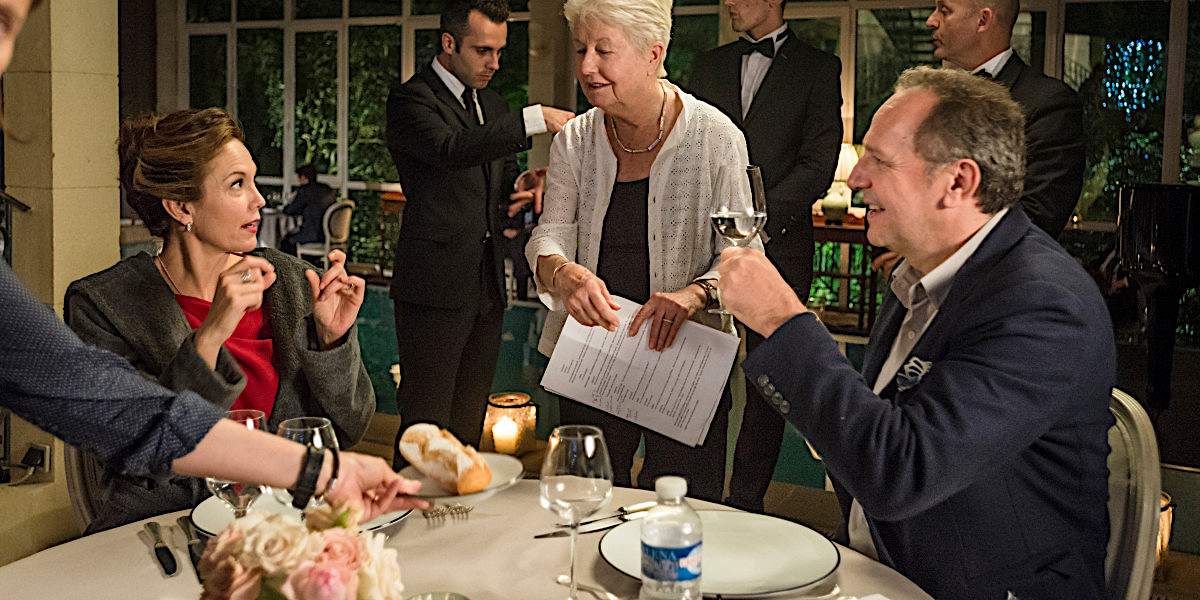
Diane Lane and Arnaud Viard in "Paris Can Wait" (2016)
HAPPY ST. VALENTINE'S DAY!
IN THIS ISSUE
WHERE TO FIND THESE CLASSIC AMERICAN DISHES
AT THE PLACES THEY WERE CREATED
By John Mariani
NEW YORK CORNER
LOVE AND PIZZA
CHAPTER FORTY-SEVEN
By John Mariani
NOTES FROM THE WINE CELLAR
THE WINES OF UMBERTO CESARE:
AN INTERVIEW
By John Mariani
❖❖❖
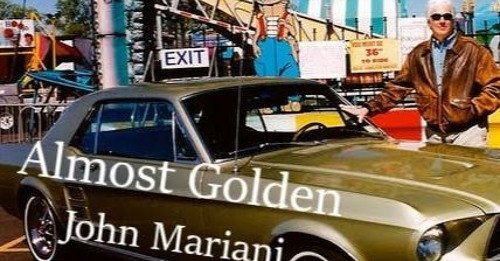
AT THE PLACES THEY WERE CREATED
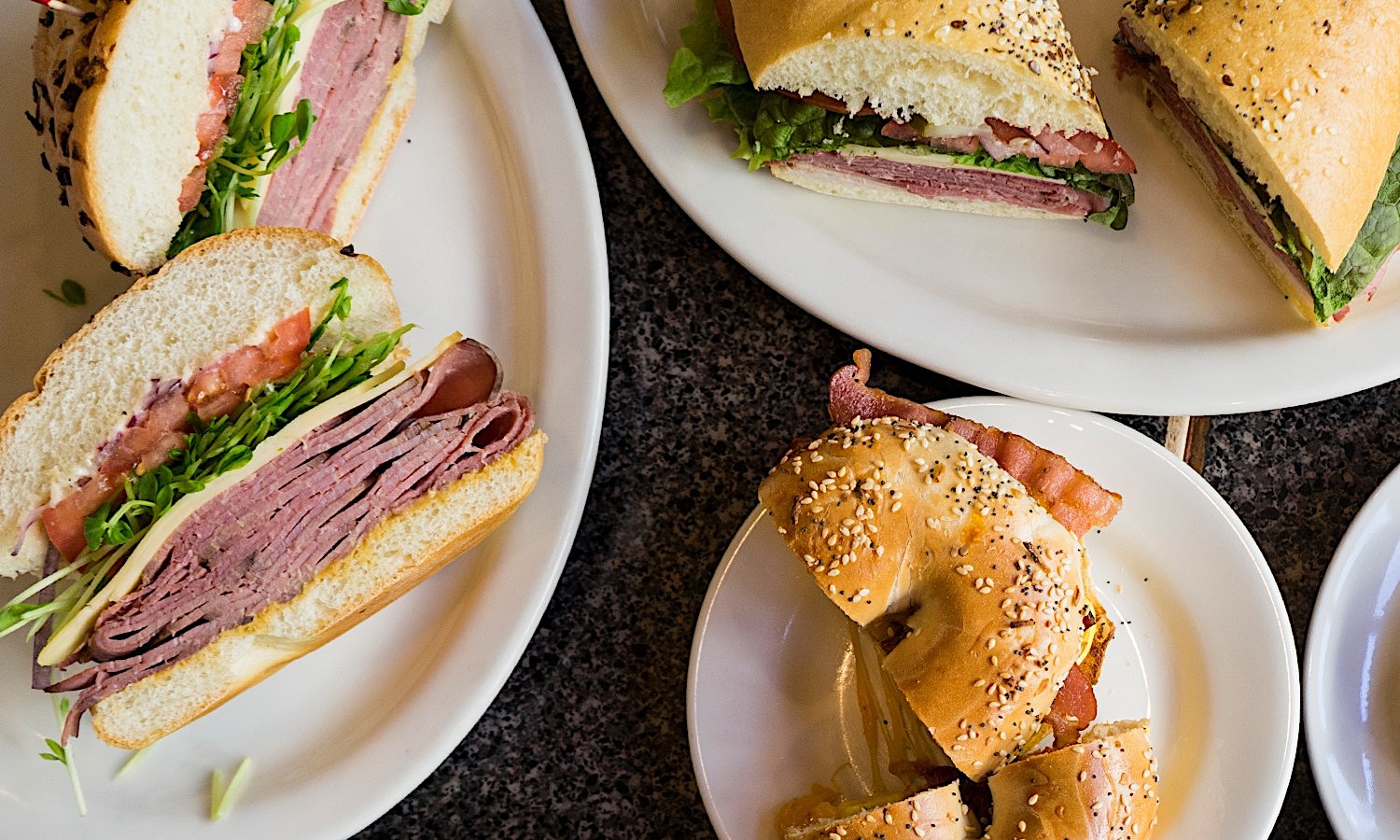
The Muffuletta at Central Grocery, New Orleans
Every dish, whether great or modest,
had to have a moment of creation. Some born from
necessity, others by accident, the original
dishes caught on and became classics for very
good reasons and have been widely imitated by
cooks all over the world. Here are ten places
where you can still get these enduringly popular
American dishes, where they haven’t changed a
thing about the original recipe. When the Covid
pandemic lifts, these restaurants will still be
serving them all.
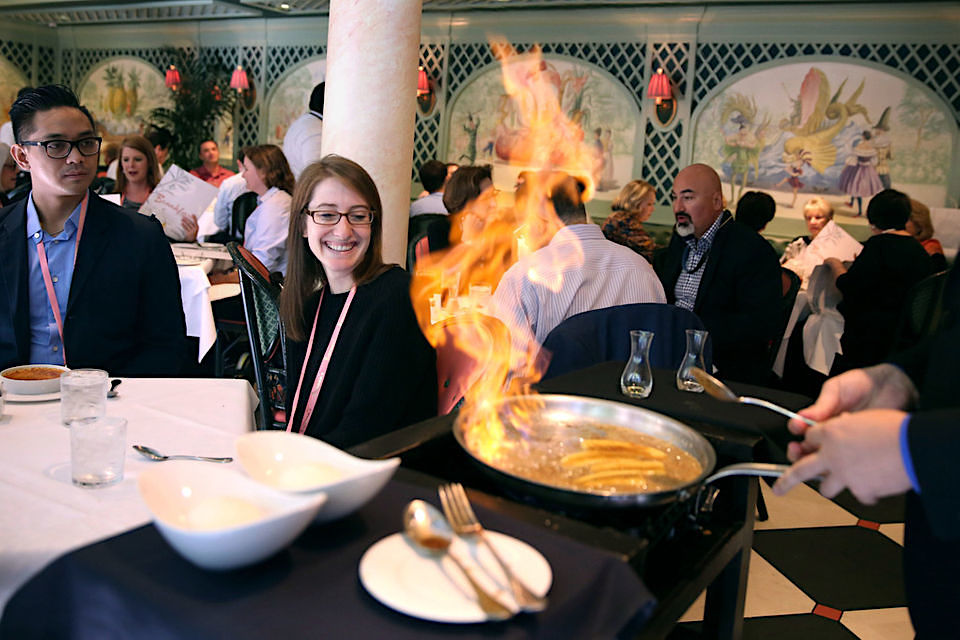 Lobster
Newburg— A rich dish of lobster meat,
sherry, egg yolks, cream and cayenne pepper made
famous at Delmonico’s
restaurant in New York in 1876, when the
recipe was brought to chef Charles Ranhofer by a
West Indies sea captain named Ben Wenberg. It was
an immediate hit, especially for after-theater
suppers, and owner Charles Delmonico honored the
captain by naming the dish “lobster à la Wenberg.”
But later Wenberg and Delmonico had a falling-out,
and the restaurateur took the dish off the menu,
restoring it only by popular demand by renaming it
“lobster à la Newberg,” reversing the first three
letters of the captain’s name. Chicken à la King
and Eggs Benedict are also Delmonico’s creations.
Lobster
Newburg— A rich dish of lobster meat,
sherry, egg yolks, cream and cayenne pepper made
famous at Delmonico’s
restaurant in New York in 1876, when the
recipe was brought to chef Charles Ranhofer by a
West Indies sea captain named Ben Wenberg. It was
an immediate hit, especially for after-theater
suppers, and owner Charles Delmonico honored the
captain by naming the dish “lobster à la Wenberg.”
But later Wenberg and Delmonico had a falling-out,
and the restaurateur took the dish off the menu,
restoring it only by popular demand by renaming it
“lobster à la Newberg,” reversing the first three
letters of the captain’s name. Chicken à la King
and Eggs Benedict are also Delmonico’s creations.
Bananas Foster—(left) A dessert made
from sliced bananas cooked with butter, brown
sugar, then flamed with rum and banana cordial and
served with vanilla ice cream. The dish was
created by chef Paul Blange in the early 1950s at
Brennan’s
restaurant in New Orleans as part of a
Breakfast at Brennan’s promotion that has since
become a city tradition. It was named after a
regular customer, Richard Foster, owner of the
Foster Awning Company in New Orleans.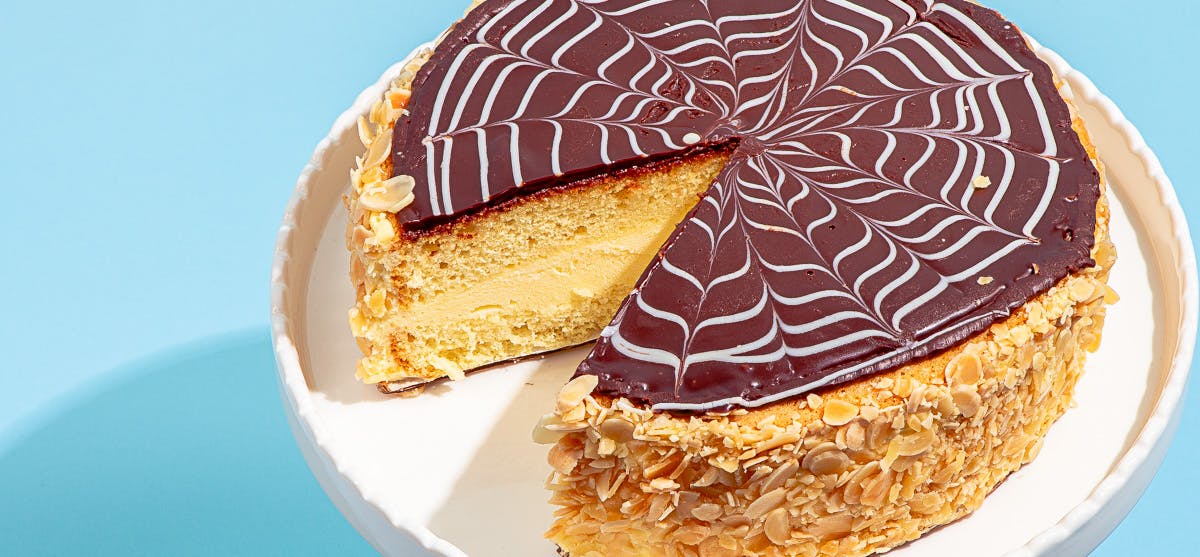
Boston Cream Pie—(right) A pie made of
white cake and custard filling or topping. If
chocolate icing is added, it is called “Parker
House chocolate pie,” after the Parker House
Hotel in Boston, where the embellishment was
first contrived. The first mention of the dessert
as “Boston cream pie” was in the New York
Herald in 1855. The hotel is also
responsible for Parker House rolls.
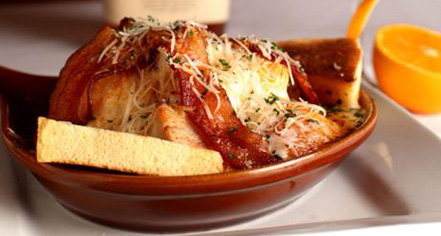
Hot Brown—(left) A sandwich of
chicken, bacon, or ham with a cheese sauce,
created at Louisville’s Brown Hotel in 1926 by
chef Fred K. Schmidt as a late-night dish. It is
still the specialty of the house at the hotel’s
restaurants, including the English Grill, J. Graham’s
Café and the Lobby Bar. You’ll find it elsewhere
in the city, but the oldest is still the best.
Irish Coffee—(right) A blend of hot
coffee, Irish whisky, and 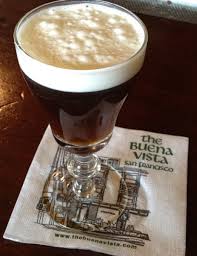 whipped cream. According to a
plaque outside the Buena Vista
Bar in San Francisco, “America’s first Irish
coffee was made here in 1952. It was
inspirationally invented at [Dublin’s] Shannon
Airport by [chef] Joe Sheridan. It was
fortuitously introduced by [newspaper writer] Stan
Delaplane. It was nurtured to a national
institution by [bar owner] Jack Koeppler.”
Sheridan actually created the drink in 1942 at
Foynes Dock, where flying boats docked in World
War II. It was promoted as of 1947 at Shannon
Airport as an official welcoming beverage. (In the
19th century the term “Irish coffee” was slang for
whiskey, entering print in 1875.)
whipped cream. According to a
plaque outside the Buena Vista
Bar in San Francisco, “America’s first Irish
coffee was made here in 1952. It was
inspirationally invented at [Dublin’s] Shannon
Airport by [chef] Joe Sheridan. It was
fortuitously introduced by [newspaper writer] Stan
Delaplane. It was nurtured to a national
institution by [bar owner] Jack Koeppler.”
Sheridan actually created the drink in 1942 at
Foynes Dock, where flying boats docked in World
War II. It was promoted as of 1947 at Shannon
Airport as an official welcoming beverage. (In the
19th century the term “Irish coffee” was slang for
whiskey, entering print in 1875.)
Muffuletta— A hero-type sandwich on a
large, round Italian bread loaf stuffed with ham,
Genoa and mortadella salami, cheeses, and pickled
olives. It is a specialty of New Orleans, where it
was created at the Central
Grocery in 1906 by Salvatore Lupo, based on
a Sicilian sandwich, although the word itself,
according to the Oxford
English Dictionary, does not appear in print
until 1967.
Muffuletta is a Sicilian dialect word for a
round loaf of bread baked so that the center is
hollow, so it may be stuffed, usually with ricotta
cheese.
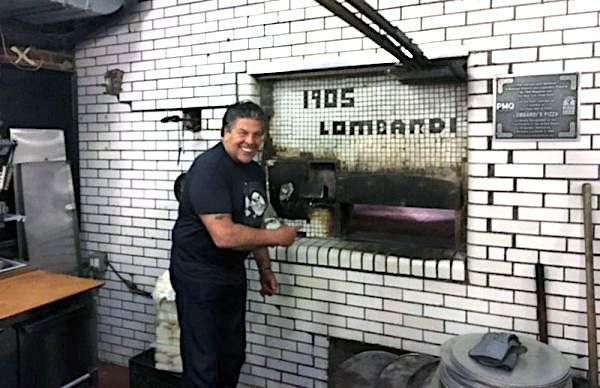
Pizza—While the first pizza alla
Margherita, with tomato, mozzarella and
basil (the colors of the Italian flag), was
created in Naples in 1889, it was just sixteen
years later that immigrant Gennaro Lombardi made
his own at his namesake pizzeria on Spring Street
in New York, before others followed in the Italian
communities around the city. Gennaro
Lombardi’s moved from its original address
but is still on Spring Street. Enrico Caruso was a
regular.
Buffalo Chicken Wings—Deep-fried chicken wings served
with a hot sauce and a blue-cheese dressing
originated at the Anchor Bar
in Buffalo, New York, on October 30, 1964,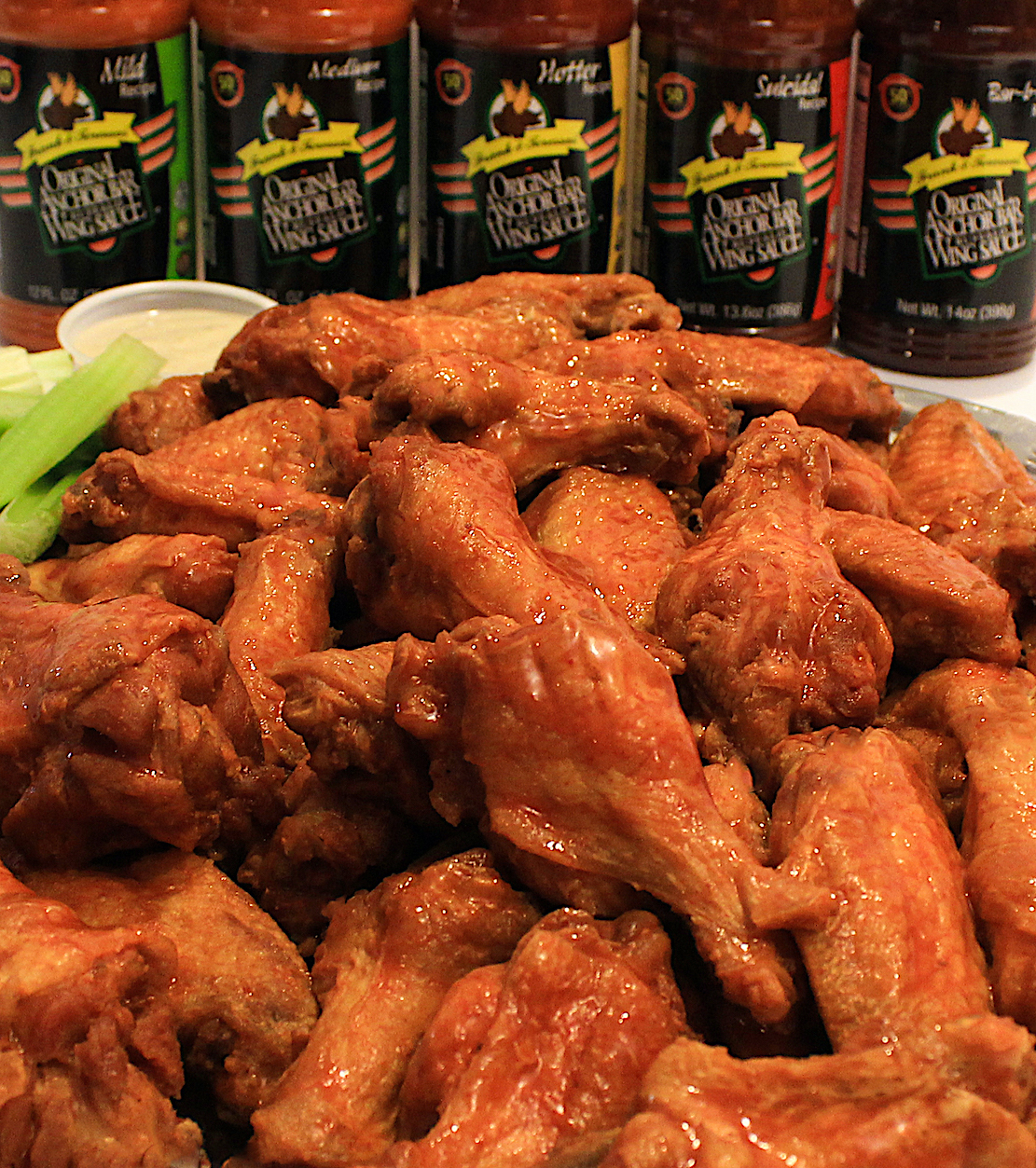 when owner Teressa
Bellissimo, having just received an oversupply of
chicken wings, was asked by her son Dominic and
his friends for something to nibble on. According
to Dominic, “She cut off the doohickeys, fried
them, drained them and swished them around in
margarine. Then she improvised on the hot sauce
and put blue cheese dressing—our house dressing—on
the side.” Being Catholics, the Bellissimos did
not eat meat on Fridays, so they waited until
midnight to serve the first wings. The dish became
an immediate hit and in 1977 the city of Buffalo
declared July 29 “Chicken Wing Day.”
when owner Teressa
Bellissimo, having just received an oversupply of
chicken wings, was asked by her son Dominic and
his friends for something to nibble on. According
to Dominic, “She cut off the doohickeys, fried
them, drained them and swished them around in
margarine. Then she improvised on the hot sauce
and put blue cheese dressing—our house dressing—on
the side.” Being Catholics, the Bellissimos did
not eat meat on Fridays, so they waited until
midnight to serve the first wings. The dish became
an immediate hit and in 1977 the city of Buffalo
declared July 29 “Chicken Wing Day.”
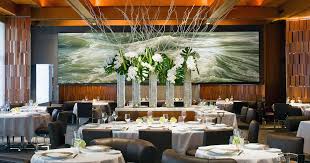 Seafood
Carpaccio—Upon opening Le Bernardin
(left) restaurant in New York in 1986,
brother and sister Gilbert and Maguy Le Coze, from
Brittany, France, committed to using American
seafood as much as possible, and came up with the
idea of serving raw, sashimi-like seafood paper
thin, like beef carpaccio (invented at Harry’s Bar
in Venice, Italy) and dress it with a light
mayonnaise. It was an overnight hit whose
repercussions made raw fish ubiquitous on menus
worldwide.
Seafood
Carpaccio—Upon opening Le Bernardin
(left) restaurant in New York in 1986,
brother and sister Gilbert and Maguy Le Coze, from
Brittany, France, committed to using American
seafood as much as possible, and came up with the
idea of serving raw, sashimi-like seafood paper
thin, like beef carpaccio (invented at Harry’s Bar
in Venice, Italy) and dress it with a light
mayonnaise. It was an overnight hit whose
repercussions made raw fish ubiquitous on menus
worldwide.
Cincinnati Chili—“Cincinnati chili” was the
creation of Macedonian immigrant Athanas
Kiradjieff, who settled in Cincinnati and opened a
hot-dog stand called the Empress (named after the
Empress Burlesque Theater in the same building),
where in 1922 he concocted a layered chili
(seasoned with Middle Eastern spices) that could
be served in various “ways.” “Five-way” chili was
the most elaborate—a mound of spaghetti topped
with chili, then chopped onions, then red kidney
beans, then shredded yellow cheese, and served
traditionally with oyster crackers and a side
order of two hot dogs topped with shredded cheese.
Kiradjieff later changed the name of his chain of
eateries to Empress
Chili, now a chain in Ohio and Kentucky.
❖❖❖
By John Mariani
LOVE AND PIZZA
Since, for the time being, I am unable to write about or review New York City restaurants, I have decided instead to print a serialized version of my (unpublished) novel Love and Pizza, which takes place in New York and Italy and involves a young, beautiful Bronx woman named Nicola Santini from an Italian family impassioned about food. As the story goes on, Nicola, who is a student at Columbia University, struggles to maintain her roots while seeing a future that could lead her far from them—a future that involves a career and a love affair that would change her life forever. So, while New York’s restaurants remain closed, I will run a chapter of the Love and Pizza each week until the crisis is over. Afterwards I shall be offering the entire book digitally. I hope you like the idea and even more that you will love Nicola, her family and her friends. I’d love to know what you think. Contact me at loveandpizza123@gmail.com
—John Mariani
To read previous chapters go to archive (beginning with March 29, 2020, issue).
LOVE AND PIZZA
Cover Art By Galina Dargery
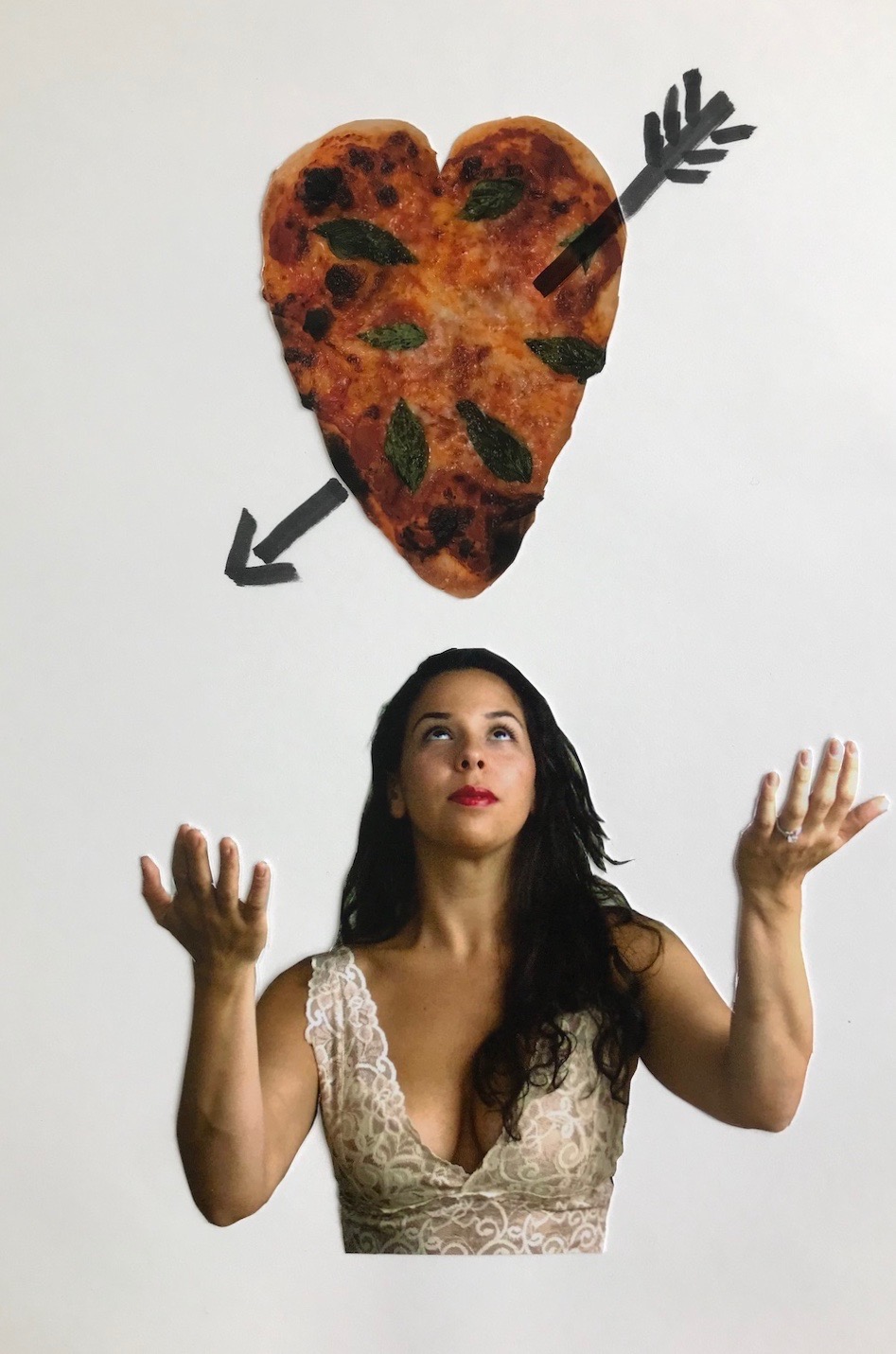
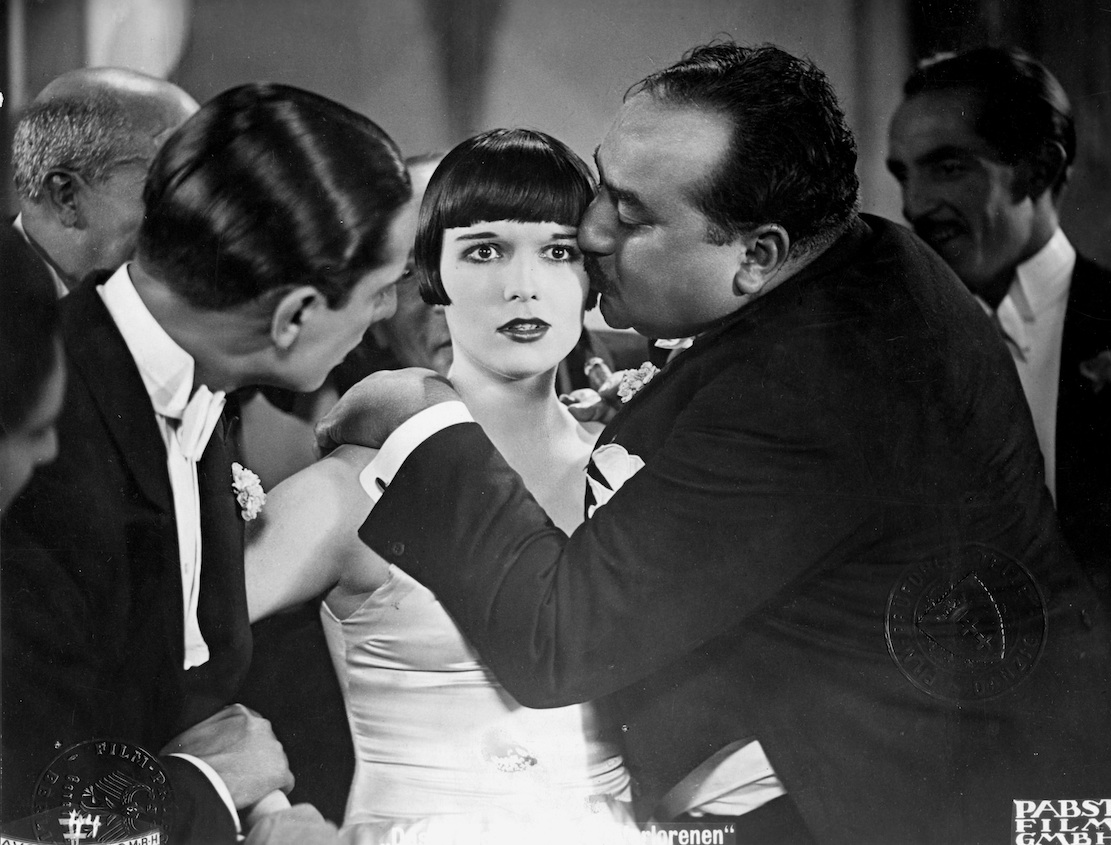
LOUISE BROOKS IN "DIARY OF A LOST GIRL" (1929)
CHAPTER
FORTY-SEVEN
Signora
Palma’s theme that season was Hollywood
actresses of the 1920s, including Marlene
Dietrich and Greta Garbo, with Nicola playing
Louise Brooks, bob and all. Nicola
did so well that she was asked to stay to do
magazine work for the next week, at a very good
fee SNAP had arranged.
The problem was how to tell Marco that
another week would go by without them seeing each
other. She
believed that abject apologies would be the only
way to appease Marco, but she was wrong.
“Oh, Marco,” she said over a bad phone
connection. “I am heartbroken not to be with you
next week but I can’t turn down this work. I owe
so much to my agency. I am so sorry, cara. Can you
forgive me?”
“So, Nicolina,” he said. “You say you are
heartbroken? Or do you mean you have no heart? There’s
a big difference.”
“I swear, Marco, when I get back I will
take a vacation, no jobs, no shooting for two
weeks, okay?
How’s that sound?”
“It sounds like I’ll see you when I see
you,” answered Marco and the phone clicked off.
Nicola was frightened. She immediately
called her agency and said she needed a two-week
vacation, which was greeted with no small degree
of dismay by the booker, who said, “Steven wants
to speak with you, Santini.”
Steven got on, saying his phone hadn’t
stopped ringing, everyone wanting to get Nikki
Santini.
Nicola let him go on for a full minute,
rattling off the impressive names of those who
wanted to hire her immediately, then she said,
“Steven, that’s all great, but I’m really
exhausted and I need to take a vacation. Just two
weeks, please.”
“Aw, Nikki, this is not a good time for
that. You gotta strike when the iron is hot,
sweetheart, and you are red hot. Hell,
you’ve even become known by just your first name,
like Twiggy and Iman and Verushka. Look,
things start to slow way down as of middle of May
through Labor Day.
Except for the lay-outs the magazines have
to do for the November and December issues,
everything else gets quiet. The
whole industry goes on vacation. They even close
down all the clothing factories. Just give
yourself until middle of May, then, fine, take off
the whole month of June.”
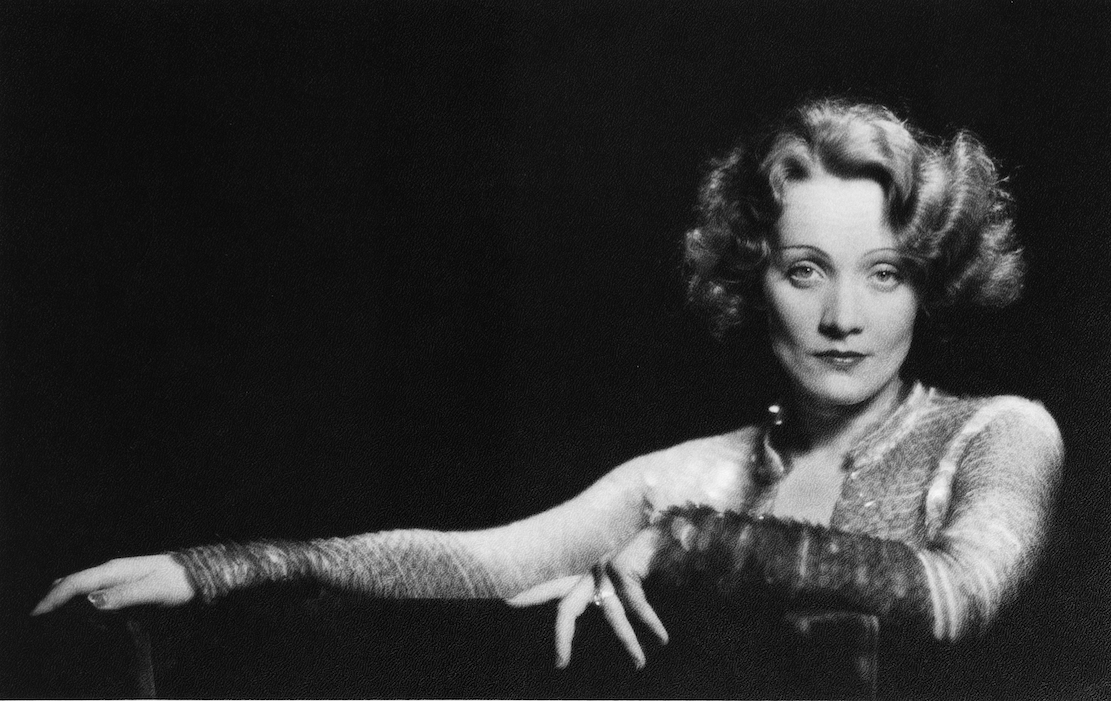 “There’s more
to it than that,” said Nicola.
“There’s more
to it than that,” said Nicola.
“Family crisis?”
“No.”
“Oh, Nikki, tell me it’s not your love
life. You
know how many models have gone down the tubes over
some guy they went off with, even married.”
“It’s not really like that. But
there is a man involved. But let me talk to him,
and, Steven, thanks for all the support. You know
I really, really appreciate it.”
“And you make a lot of money for this
agency, Nicola. So we’re even, kiddo.”
Nicola didn’t dare approach the subject
again with Marco until they could see each other.
When she got back in a week, she’d have to renege
on the immediate vacation but she could most
probably fix things so she didn’t have to go out
of the country on location.
The second week in Milan went by quickly
because Nicola was very busy, but she begged off
even more offers to stay on, hurrying back to New
York as soon as possible after her last job.
She
did not hear from Marco but thought—hoped,
really—he was just acting like a child and
pouting. But after two days at home, the only
phone calls were from SNAP.
Then,
on the third day, Marco called, though with no
discernible repentance in his voice. Nicola told
herself she would happily play the one to take the
blows of criticism as long as Marco could get it
out of his system.
“I really need to see you, Marco,” she
said. “How about tomorrow night?”
“I’m working tomorrow. Next
day?”
“Sure, next day is fine. Where,
when? Come here to the apartment. We’ll have some
wine and talk.”
There wasn’t much to decipher in the
brevity of Marco’s
remarks, but she took some hope in the mention of
the wine.
Two days later
Nicola made sure she looked her very best without
looking “model-y,” which Marco always found
excessive.
The doorman let her in without calling
upstairs, and she took the elevator to Marco’s
apartment. He
was waiting with the door open, smiling only a
little. They
embraced, kissed briefly and sat down. The
bottle of wine was not yet opened.
They both said, “So ...” at the same time.
“You first,” said Marco. “How was Milan?”
“Very hectic, very profitable though. The
shows went well. What about you? Va bene?”
“Not much to tell you. Work, painting a
little, not much. I was lonely, as usual.”
“So was I, Marco. I so
wish you’d been with me.”
“Oh, I’m sure you were busy with the
parties with all the big fashionistas and the male
models and all the parasites who hang around
them.”
“Marco, give me some credit. Those
are not my kind of people.”
“Perhaps, but all that glamour can be
seductive. And you were a lonely American girl in
beautiful Milan, and . . .”
Nicola almost slapped him but then realized
he was trying to tell her something about himself.
“And what about you, Marco? Handsome
young Italian painter who can cook a girl right
off her feet? What about you?”
Marco was silent. Nicola’s
mouth dropped.
“You slept with someone while I was gone?”
Marco lifted his chin, as if it deserved to
be slapped.
“Nicolina, I told you I was lonely, and I
was very, very angry with you. I didn’t even know
if I would ever see you again. It was nothing.
Just a girl.”
“Just a girl?
And where did you meet this girl,” saying
the word as if akin to gumar.
“In the museum. We started talking, and . .
.”
Nicola’s eyes were tearing up and she
started to wave her hands.
“I
cannot deal with this now, Marco,” she screamed.
“I go away for two weeks and you screw another
woman? What
kind of person are you? Did you
really think we wouldn’t see each other again? Or
was that just a goddamn excuse? You make
me sick!”
Marco tried to calm her down but Nicola
would not have any of it. She grabbed her jacket
and started for the door. “Cara,
Nicolina, please!” he implored her. “Let’s have
some wine and talk.”
Nicola flashed her eyes at him and said,
“You know what, Marco? I’m done talking, so why
don’t you take that cheap bottle of wine and shove
it!”
By the time Nicola hit the street, she was
deep in tears. She ran to a phone booth on the
corner and dialed Catherine’s number.
“Hello?”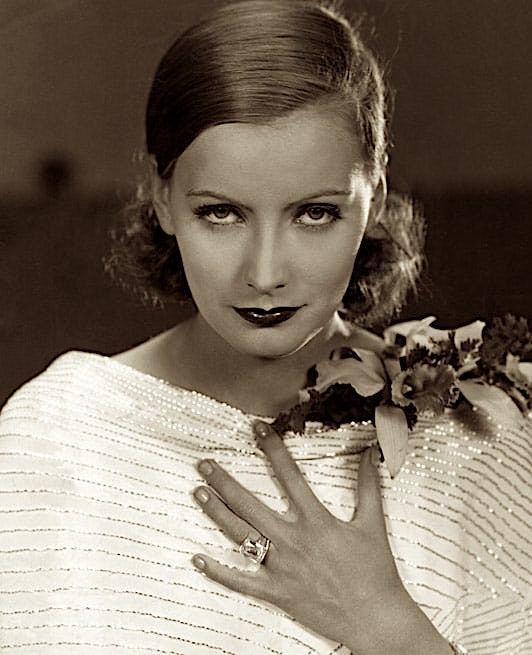
“Catherine, it’s Nicky.”
“What’s up?”
“Can I come over to your dorm? Right
now?”
Fifteen minutes later Nicola was in
Catherine’s arms, trying to tell her what happened
between patches of sobs.
After Catherine calmed Nicola down, she
said, “I’m really sorry about all this, Nick. You
sure don’t deserve it.”
“Well, maybe I do!” answered Nicola. “Maybe
I shouldn’t expect a guy like Marco to wait around
for me to get back from this show or that shoot
all over the world and ask him to act like a
saint.”
“Nicky, he had no right to screw that
girl.”
“I don’t know anymore. All I
know is that I can’t trust him and, in a different
way, he can’t trust me. I tell
him I’m taking a vacation, then I can’t. Or won’t.
Maybe it’s too much to ask.”
Catherine tried to take
her friend’s side but knew in her heart that
Marco’s patience had been more than stretched to
the limit. It
had snapped and now tying the two of them back
together might be impossible.
“Listen, Nick, how about when you get some
time—you said you’d be free in June?—how about you
and I go to Paris?
Forget all about Italy and the goddamn
Italians. Just the two of us! We’ll
eat croissants and chocolate and gain five
pounds.”
Nicola smiled
slightly and said, “Funny thing is, now I can
afford the airfare and hotel. I just can’t afford
to put on five pounds. Everybody
I work with says I should lose ten.”
“Well, then, you can starve yourself. Come
on, we’ll go to the Louvre and the opera, stroll
the boulevards, maybe even meet some nice French
guys, if there
are any.”
“Thanks, Catherine, but that’s about the
last thing on my mind right now. I think the
better thing for me to do would be to throw myself
into work for the summer, then see what happens
when I go back to school in the fall.”
AN INTERVIEW
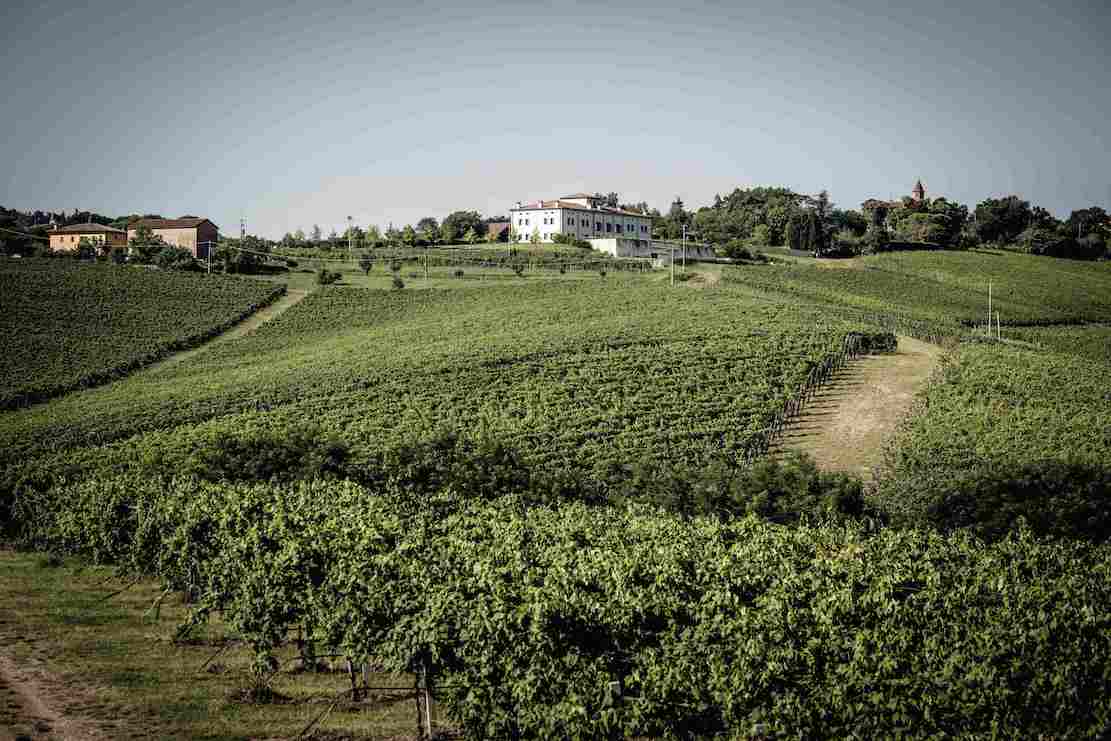
Unlike
the wines of northern Italian regions like
Tuscany, Piedmont and the Veneto, those of
Emilia-Romagna are less well known and haven’t the
marketable reputation of the others. Its best
known wine is Lambrusco, whose own reputation as a
sweet bubbly wine is based on oceans of plonk from
big name wineries like Reunite. Working hard to
change the region’s reputation is the 50-year-old
winery Umberto Cesari, which specializes in
Sangiovese wines, along with Albana, Pignoletto
and Trebbiano as well as international varietals
like Cabernet Sauvignon, Merlot, Chardonnay and
Sauvignon Blanc. Innovations and a focus on
terroir at eight ‘poderi’ or fields
(Claterna, Casetta, Parolino, Laurento, Ca’
Grande, Miravalle, Tauleto and Liano) spread over
355 hectares of clay-rich vineyards protected by
the Calanchi Azzurri “badlands” and enjoying a
mild climate.
To find out what the current plans for
Umberto Cesari are, I spoke with Gianmaria Cesari,
son of the late founder.
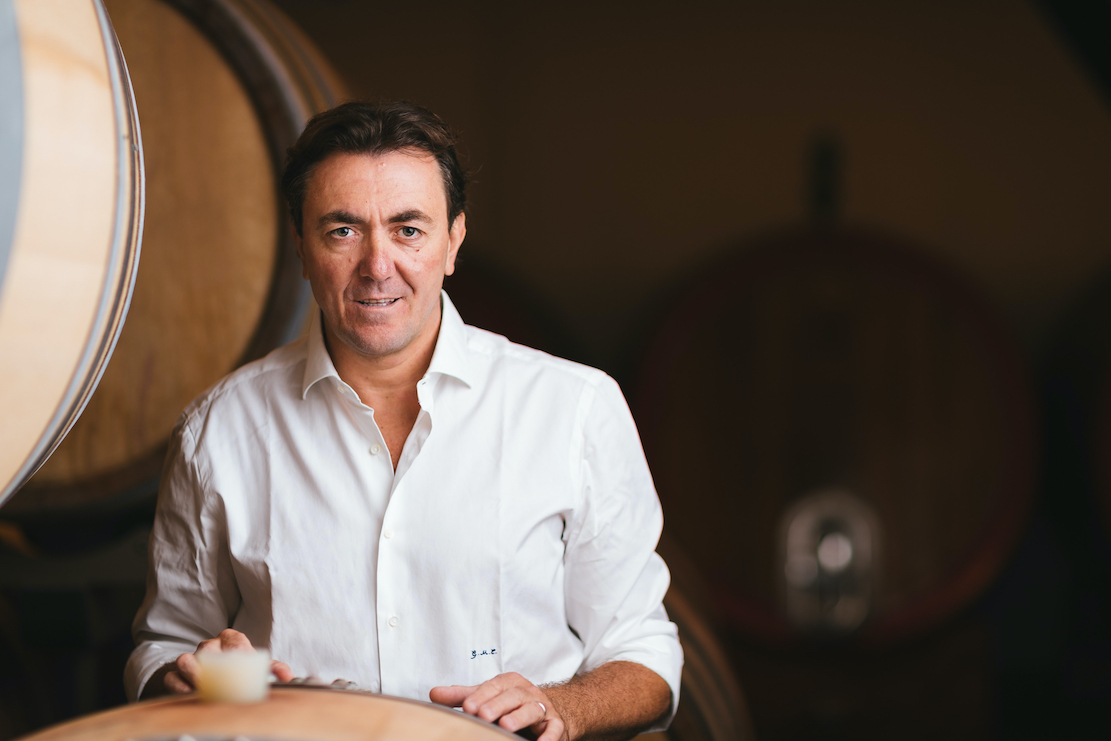
1. Your winery has
been a champion of Emilia-Romagna wines, which
has not had anything close to the reputation of
Tuscany and Piedmont. Why do you think that has
been the case?
I think that
Emilia-Romagna has not promoted its wines, and its
territory, like other regions in Italy, but I
still consider Emilia-Romagna to be the best kept
secret of Italy and yet to be discovered.
2. What
potential did you see in ER back in the 1960s,
when Albana and Lambrusco were the only wines
most people knew? Do you make a Lambrusco? If
not, why not?
Back then it was a completely
different world. Albana wine has been very popular
in the past and I still consider Albana one of the
best white grapes of Italy. Albana has a special
bond with Romagna, which geologically and
climatically is very different from Emilia.
Indeed, the attempts at cultivation in other areas
have not produced interesting results. It is no
coincidence that in 1987 Albana was recognized as
the first white wine DOCG in Italy, which is
attributed only by virtue of a deep link between
the vines and the cultivation area, both in terms
of territorial vocation and cultural tradition.
Albana is also a particularly acidic white grape,
rich in tannins, and this means that even in the
past, when there was no technology, it was
possible to make a wine that would maintain the
white color (Albana derives from the Latin term albus,
which means “white par excellence”) and ages very
well over time. Furthermore, Albana has shown
itself to be particularly resilient with climate
change; indeed, at times it expresses itself
better now than in the past.
As far as Lambrusco is concerned, it
is important to notice that Lambrusco wines are
native grapes of Emilia and are best expressed in
that specific location. Umberto Cesari vineyards
are in Romagna, which is why the company has
dedicated its attention to typical grape varieties
of this area and, in particular, to Sangiovese and
Albana.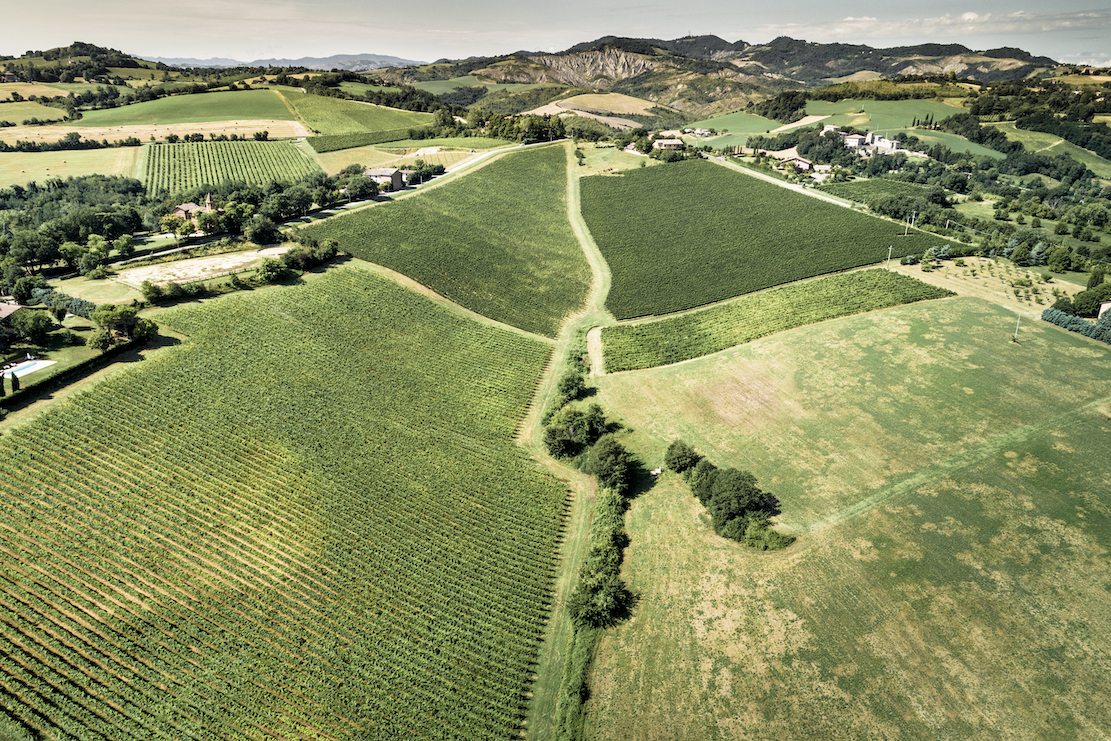
3. Does
Emilia-Romagna have many different terroirs?
Italy has so many
different terroirs, and so does Emilia-Romagna.
There is a huge difference between the flat parts
and the terroirs that you can find on the hills. Geologically speaking,
Emilia-Romagna is divided into three macro areas:
alluvial plain, hills of Emilia and hills of
Romagna. Each area differs in terms of soil,
climate, and grape varieties. In particular, the
hilly areas are affected by the exposure of the
slopes, and in Romagna also by the proximity to
the Adriatic Sea. All these variants therefore
influence the respective productions.
4. Why
did you plant Sangiovese? Was it ever grown in
Emilia-Romagna before?
I planted Sangiovese
because it has always been the most important
grape of Emilia- Romagna. Emilia-Romagna was the
first region in Italy to have been granted a DOC
appellation dedicated to the Sangiovese grape,
back in 1967 (Sangiovese di Romagna DOC) and for a
long time it was the only one, long before
Tuscany. Moreover, there are a lot of books
talking about the Romans planting Sangiovese in
the region.
5. Who
else in your family is involved in the winery? The
winery is owned by me, my mother and my sister and
we are all involved in the winery operations.
6. Please
give me a little of your own biography.
Born in Bologna, Italy, in 1975, I am the son
and first child of Umberto Cesari, the founder of
the company. I inherited the passion for wine from
my father. I graduated in economics at the
University of Bologna, and today I am managing the
winery, but still travel around the world to
promote Umberto Cesari wines.
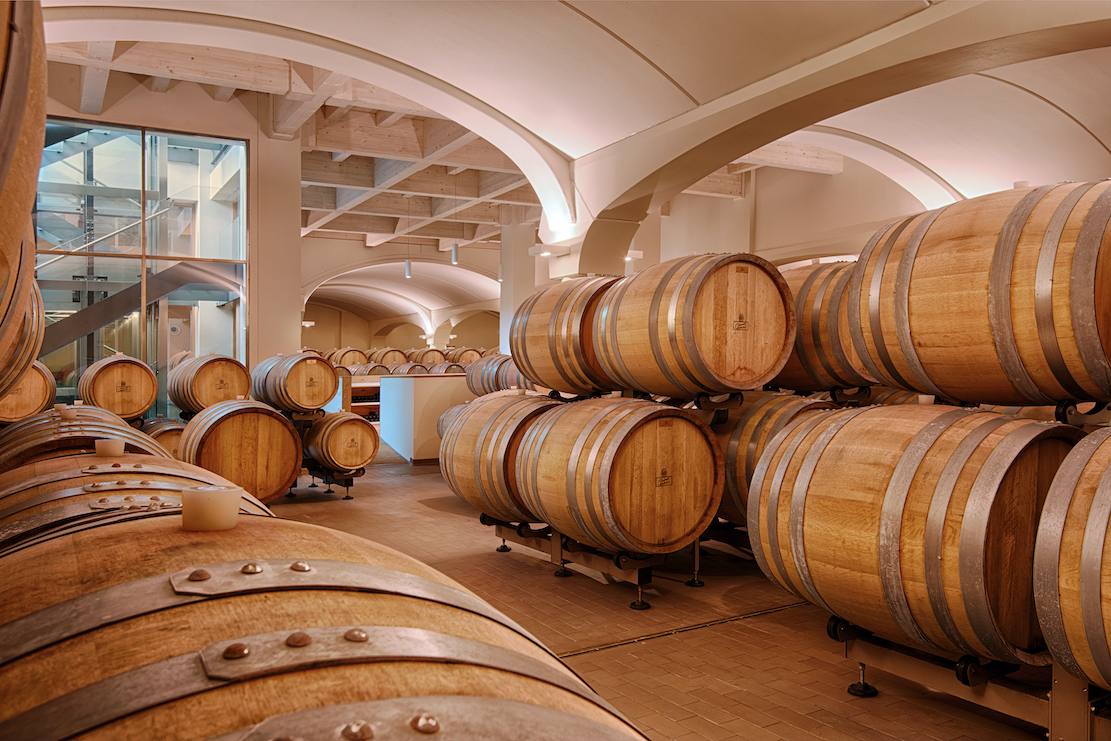
7. Is your
rosato
of Sangiovese unique?
I think it is unique.
Making a rosé with Sangiovese grapes certifies its
unicity. But it is also a completely new way of
thinking a “rosato” wine in the region. Until
today a rosé made with Sangiovese grape was like a
light red wine, while we wanted to create an
easy-to-drink, pleasant and elegant Provence-style
rosé.
8. You
also seem very devoted to eco-tourism and even a
gelato
museum. Please tell me more about them.
Eco-tourism is part of
our philosophy. We are a sustainable winery, so
tourism is sustainable as well. We promote and
organize e-bike tours with electrical bikes.
Everything we do is dedicated to preserve nature,
because we live out of nature. The gelato
museum is one of the excellences of this region.
Maybe some people don’t know the name
Emilia-Romagna, but they probably know some of the
masters of excellences that are based here. You
can think about the “motor valley” with Ferrari,
Lamborghini, Bugatti, Pagani, the Ducati
motorbikes, and next to Ducati we have one of the
oldest gelato
machinery companies that is called Carpigiani.
They are so good that people come from all over
the world to see how they make gelato,
so they created a gelato museum.
9. How has
climate change affected Emilia-Romagna?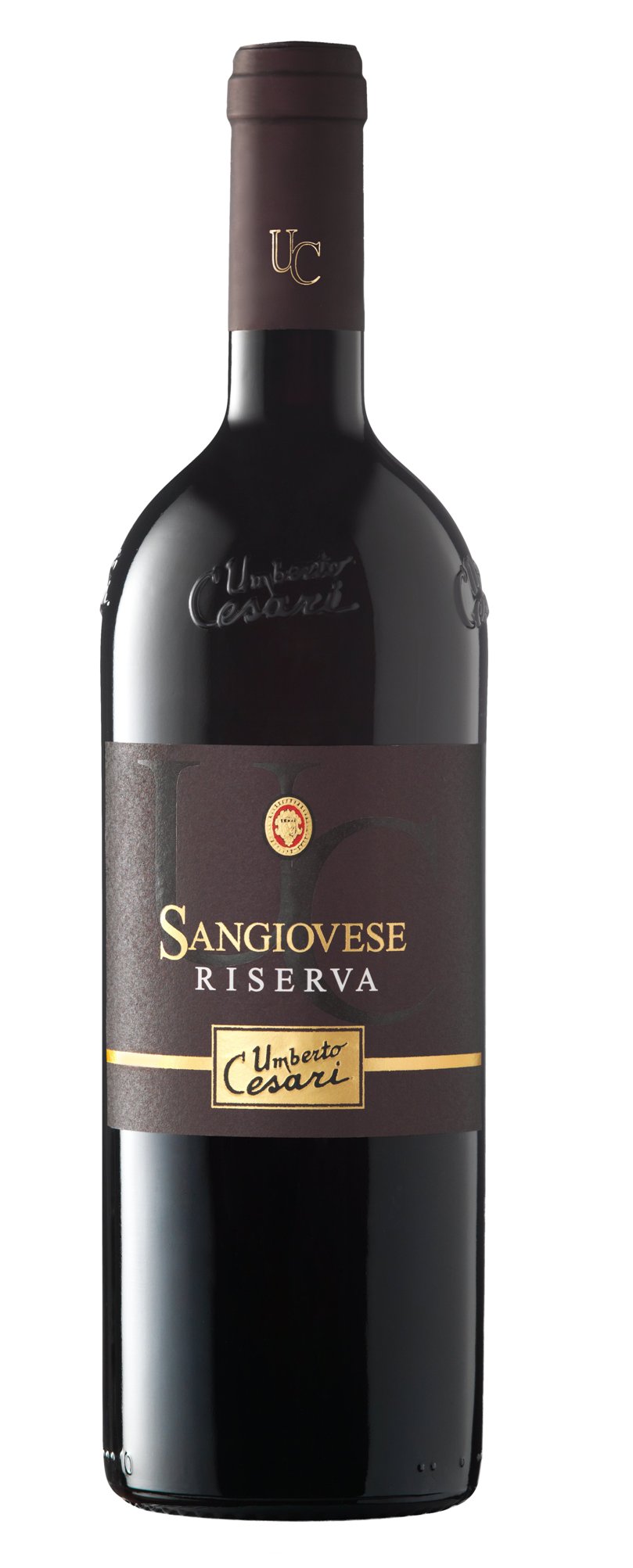
Climate change has
affected all the world. We have dedicated one of
our wines to this important topic. It is called
Resultum, a name taken from the Latin term resilire,
which means resilient, because we have seen that
our vineyards have adapted and reacted positively
to climate change. We get very little rain in the
winter and then tropical storms in the summer, and
every single year a hailstorm. We believe that
climate has changed for sure, but we cannot do
anything, we know that we have good vintages and
other times not so good.
10. Why do
you make so many wines, rather than concentrate
on a few labels?
Because, talking about
terroirs, we have different estates, and we want
to emphasize the peculiarity of each terroir. For
us it is important to make wines that are the
expression of every single terroir.
11. How do
your wines compare with other Sangioveses?
Talking about our reds,
that are made mainly with Sangiovese, the closest
comparison is with Tuscan wines. I think that our
tannins are softer and riper compared to the Sangiovese
grapes grown in Tuscany. But again, it is
difficult to make comparisons, because every
single terroir and philosophy is different.
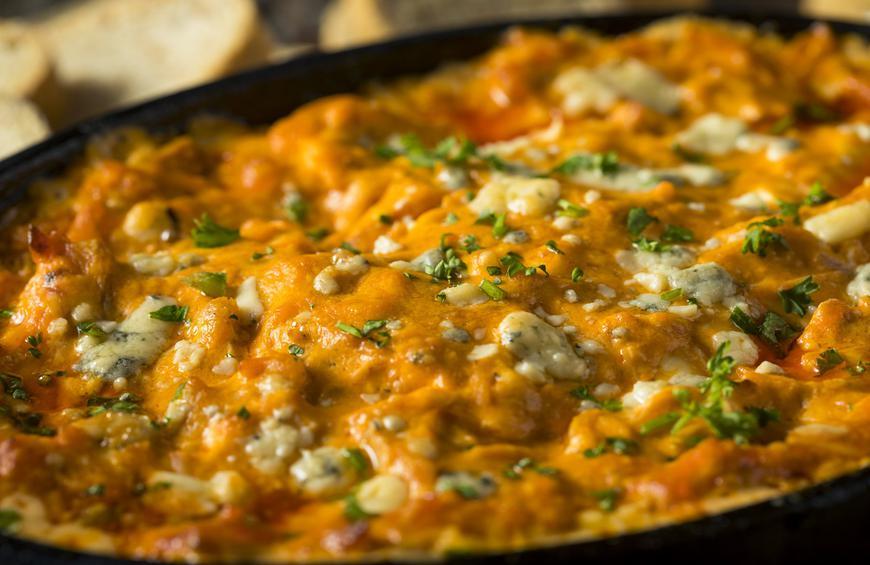
ARTICLES WE NEVER STARTED READING
"How to Turn Buffalo Chicken Dip Into a Whole Casserole"—Diamond Bridges, TheDailyMeal (11/20020)
BOOMS WE SOMEHOW MISSED

"The Birria Boom Is Complicated, but Simply Delicious"—Tejal Rao, NY Times (2/10/21)
❖❖❖
Sponsored by
/archive/2021/210214/TWI%20LOGO-1.jpg)
Any of John Mariani's books below may be ordered from amazon.com.
 The Hound in Heaven
(21st Century Lion Books) is a novella, and
for anyone who loves dogs, Christmas, romance,
inspiration, even the supernatural, I hope you'll find
this to be a treasured favorite. The story
concerns how, after a New England teacher, his wife and
their two daughters adopt a stray puppy found in their
barn in northern Maine, their lives seem full of promise.
But when tragedy strikes, their wonderful dog Lazarus and
the spirit of Christmas are the only things that may bring
his master back from the edge of despair.
The Hound in Heaven
(21st Century Lion Books) is a novella, and
for anyone who loves dogs, Christmas, romance,
inspiration, even the supernatural, I hope you'll find
this to be a treasured favorite. The story
concerns how, after a New England teacher, his wife and
their two daughters adopt a stray puppy found in their
barn in northern Maine, their lives seem full of promise.
But when tragedy strikes, their wonderful dog Lazarus and
the spirit of Christmas are the only things that may bring
his master back from the edge of despair. WATCH THE VIDEO!
“What a huge surprise turn this story took! I was completely stunned! I truly enjoyed this book and its message.” – Actress Ali MacGraw
“He had me at Page One. The amount of heart, human insight, soul searching, and deft literary strength that John Mariani pours into this airtight novella is vertigo-inducing. Perhaps ‘wow’ would be the best comment.” – James Dalessandro, author of Bohemian Heart and 1906.
“John Mariani’s Hound in Heaven starts with a well-painted portrayal of an American family, along with the requisite dog. A surprise event flips the action of the novel and captures us for a voyage leading to a hopeful and heart-warming message. A page turning, one sitting read, it’s the perfect antidote for the winter and promotion of holiday celebration.” – Ann Pearlman, author of The Christmas Cookie Club and A Gift for my Sister.
“John Mariani’s concise, achingly beautiful novella pulls a literary rabbit out of a hat – a mash-up of the cosmic and the intimate, the tragic and the heart-warming – a Christmas tale for all ages, and all faiths. Read it to your children, read it to yourself… but read it. Early and often. Highly recommended.” – Jay Bonansinga, New York Times bestselling author of Pinkerton’s War, The Sinking of The Eastland, and The Walking Dead: The Road To Woodbury.
“Amazing things happen when you open your heart to an animal. The Hound in Heaven delivers a powerful story of healing that is forged in the spiritual relationship between a man and his best friend. The book brings a message of hope that can enrich our images of family, love, and loss.” – Dr. Barbara Royal, author of The Royal Treatment.
 |
The Encyclopedia of American Food and Drink by John F. Mariani (Bloomsbury USA, $35) Modesty forbids me to praise my own new book, but let me proudly say that it is an extensive revision of the 4th edition that appeared more than a decade ago, before locavores, molecular cuisine, modernist cuisine, the Food Network and so much more, now included. Word origins have been completely updated, as have per capita consumption and production stats. Most important, for the first time since publication in the 1980s, the book includes more than 100 biographies of Americans who have changed the way we cook, eat and drink -- from Fannie Farmer and Julia Child to Robert Mondavi and Thomas Keller. "This book is amazing! It has entries for everything from `abalone' to `zwieback,' plus more than 500 recipes for classic American dishes and drinks."--Devra First, The Boston Globe. "Much needed in any kitchen library."--Bon Appetit. |
"Eating Italian will never be the same after reading John Mariani's entertaining and savory gastronomical history of the cuisine of Italy and how it won over appetites worldwide. . . . This book is such a tasteful narrative that it will literally make you hungry for Italian food and arouse your appetite for gastronomical history."--Don Oldenburg, USA Today. "Italian
restaurants--some good, some glitzy--far
outnumber their French rivals. Many of
these establishments are zestfully described
in How Italian Food Conquered the World, an
entertaining and fact-filled chronicle by
food-and-wine correspondent John F.
Mariani."--Aram Bakshian Jr., Wall Street
Journal.
"Equal parts
history, sociology, gastronomy, and just
plain fun, How Italian Food Conquered the
World tells the captivating and delicious
story of the (let's face it) everybody's
favorite cuisine with clarity, verve and
more than one surprise."--Colman Andrews,
editorial director of The Daily
Meal.com. "A fantastic and fascinating
read, covering everything from the influence
of Venice's spice trade to the impact of
Italian immigrants in America and the
evolution of alta cucina. This book will
serve as a terrific resource to anyone
interested in the real story of Italian
food."--Mary Ann Esposito, host of PBS-TV's
Ciao
Italia. "John Mariani has written the
definitive history of how Italians won their
way into our hearts, minds, and
stomachs. It's a story of pleasure over
pomp and taste over technique."--Danny Meyer,
owner of NYC restaurants Union Square
Cafe, The Modern, and Maialino.
|
 |
 |
 |
 |
 |
 |
 Everett Potter's Travel Report:
Everett Potter's Travel Report: 
 Eating Las
Vegas JOHN CURTAS has been covering
the Las Vegas food and restaurant scene
since 1995. He is the co-author of EATING LAS
VEGAS – The 50 Essential Restaurants (as
well as the author of the Eating Las
Vegas web site: www.eatinglasvegas.
He can also be seen every Friday morning as
the “resident foodie” for Wake Up With the
Wagners on KSNV TV (NBC) Channel 3 in
Las Vegas.
Eating Las
Vegas JOHN CURTAS has been covering
the Las Vegas food and restaurant scene
since 1995. He is the co-author of EATING LAS
VEGAS – The 50 Essential Restaurants (as
well as the author of the Eating Las
Vegas web site: www.eatinglasvegas.
He can also be seen every Friday morning as
the “resident foodie” for Wake Up With the
Wagners on KSNV TV (NBC) Channel 3 in
Las Vegas.
MARIANI'S VIRTUAL GOURMET
NEWSLETTER is published weekly. Publisher: John Mariani. Editor: Walter Bagley. Contributing Writers: Christopher Mariani,
Robert Mariani, Misha Mariani, John A. Curtas, Gerry Dawes, Geoff Kalish,
and Brian Freedman. Contributing
Photographer: Galina Dargery. Technical
Advisor: Gerry
McLoughlin.
If you wish to subscribe to this
newsletter, please click here: http://www.johnmariani.com/subscribe/index.html
© copyright John Mariani 2021

